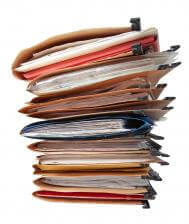Keep Your Files Looking Neat
Why tri-cut folders simply won’t do.


I chose hanging file folders because I loved how the little plastic tabs can be moved to any position. A drawer full of hanging files forming neat little diagonal rows makes my heart sing with feelings of joy and accomplishment (I spent my childhood on a farm, seeing neat orderly rows of crops from horizon to horizon. It had a permanent effect on my psyche).
When I add and remove files, the OCD part of me is annoyed by where the tabs randomly end up. Sometimes five folders in a row all have the same tab position (thus hiding the four tabs in back). Is there a quick and dirty tip that makes manila folders look as neat as corn rows.
I didn’t grow up on a farm, but I saw a picture of a farm once, so I share your concern about tri-cut manila folders not looking like neat rows of corn. I used the tri-cut folders for years. Like you, I added and removed folders until the out-of-order tabs drove me nuts! (I am not obsessive about filing. I am not obsessive about filing. Repeat 18.5 times.)
You don’t even have to add and remove folders permanently. Your file drawers can be a picture-perfect image of neatly diagonalized labels, and you’ll still suffer if you ever pull a few folders out to take with you to a client. Can you imagine pulling out two left-tab folders and a right-tab folder? Shudder You would have to pull out a center-tab folder to put between them just to restore my feeling of balance, and it’s just not allowed to carry around a folder you aren’t going to use.
Use Straight Cut Folders
My life changed when I came to my current job, however. The administrative assistant in my area used “straight cut” folders. These odd creatures have a single, long tab that goes all the way across. At first, I thought they had made some tragic mistake at the folder factory. But no, that one tab was on purpose.
It happened slowly. I asked for a folder and she nonchalantly tossed one in my direction. And at that moment, it began to infiltrate my soul.
Because the one tab goes all the way across, you see, it means you have a lot of room to write. If you use the tips in my original filing episode (there’s a link in this episode’s transcript on the Quick and Dirty Tips website) and create files in a hierarchy, you have lots of writing room. There’s room for useful titles like, “World Domination, Zombie Army scenario, Zombie slime cleanup logistics.”
Not only do you have writing room, but you can rearrange, add, and subtract files with impunity. If you have a file called, “Kids, childhood artwork,” and “Kids, yearly report cards,” you can easily insert “Kids, therapy bills caused by” right between those two and your file will look just as neat as when you began.
While it’s true that our platonically ideal tri-cut system makes it easier to read the labels on the file folders, with the straight-cut folders, you can just riffle through with your finger to see the labels. In practice, it’s much easier than trying to riffle through a drawer with poorly distributed tri-cut folders.
Call in the Reinforcements
The problem with riffling is that pretty soon, you end up with a finger-shaped indentation along the folder tabs where you do your riffling. That’s because you didn’t buy reinforced straight-cut folders. In fact, whichever folders you use, reinforced tabs keep the top from getting kinda grimy and shredded from handling. If you want neat, pristine-looking folders year after year, reinforced tabs are the way to go. They also feel better, are more solid, and are able to stand up to your heavy-duty organizing activities.
Hanging is Still Legal in Offices
Finally, let’s address the truth about those absurd hanging files: they only exist to make the stationery companies money. They waste a lot of space, since the little metal bars that hold them up are deceptively thick when you have a couple of dozen in your filing cabinet. And why do we need them, anyway? They just add that much more effort to hanging, labeling, and rearranging when a hanging file gets full. If the issue is grouping lots of related files in one place, just use hierarchical labels.
My advice is to skip the hanging files altogether unless they’re required by law in your state. Even then, don’t use the tabs on the hanging files. If you label a hanging file, you’re obligated to fill it just with related manila folders. You already made the mistake of bringing your sweetie breakfast in bed on your first anniversary; you don’t need to add obligations to your file folders on top of that.
If you’ve become addicted to the hanging files, though, extend the one-tab idea to your hanging files. Rather than staggering the tab in neat diagonal rows that will decay over time, put all the tabs in the same place so you can riffle through them with your finger.
Movable tabs only stay neat-looking if you can set up the system once and then never add or remove folders. In that fantasy world, Santa Claus is real and politicians have your best interest at heart. Use straight-cut folders and get the reinforced tabs. You’ll have ample room for each file label, you can add and subtract files neatly, and you can use a simple riffle to scan the whole drawer.
So remember: One tab to label all, one tab to find them, one tab that’s reinforced, with lots of room to write in.
This is Stever Robbins. Email questions to getitdone@quickanddirtytips.comcreate new email or leave voicemail at 866-WRK-LESS.
Work Less, Do More, and have a Great Life!
RESOURCE:
- /productivity/organization/file-so-you-can-find-anything-instantly – episode on how to label your file folders
Messy Folders image courtesy of Shutterstock

